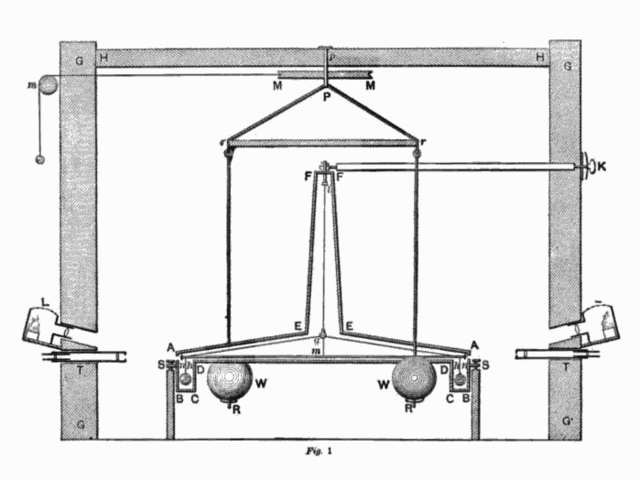 |
This is a file from the Wikimedia Commons. Information from its description page there is shown below.
Commons is a freely licensed media file repository. You can help.
|
Summary
| Description |
English: Drawing of torsion balance apparatus used by Henry Cavendish in the 'Cavendish Experiment' to measure the gravitational constant in 1798. This is a vertical section through the apparatus, including the building that housed it. Copy of Figure 1 from his 1798 paper 'Experiments to determine the Density of the Earth' published in Philosophical Transactions of the Royal Society of London, (part II) 88 p.469-526 (21 June 1798). Alterations: removed frame and caption, compensated for shear distortion caused by scanning book, converted to PNG.
|
| Date |
21 June 1798 |
| Source |
Cavendish,H.(1798), 'Experiments to determine the Density of the Earth' in McKenzie, A.S. ed. Scientific Memoirs Vol.9: The Laws of Gravitation, American Book Co. 1900, p.62 on Google Books. |
| Author |
Henry Cavendish |
Permission
( Reusing this file) |
Public domain - author died in 1810.
|
Licensing
| Public domainPublic domainfalsefalse |
 |
This image (or other media file) is in the public domain because its copyright has expired.
This applies to Australia, the European Union and those countries with a copyright term of life of the author plus 70 years.
 You must also include a United States public domain tag to indicate why this work is in the public domain in the United States. Note that a few countries have copyright terms longer than 70 years: Mexico has 100 years, Colombia has 80 years, and Guatemala and Samoa have 75 years, Russia has 74 years for some authors. This image may not be in the public domain in these countries, which moreover do not implement the rule of the shorter term. Côte d'Ivoire has a general copyright term of 99 years and Honduras has 75 years, but they do implement the rule of the shorter term. You must also include a United States public domain tag to indicate why this work is in the public domain in the United States. Note that a few countries have copyright terms longer than 70 years: Mexico has 100 years, Colombia has 80 years, and Guatemala and Samoa have 75 years, Russia has 74 years for some authors. This image may not be in the public domain in these countries, which moreover do not implement the rule of the shorter term. Côte d'Ivoire has a general copyright term of 99 years and Honduras has 75 years, but they do implement the rule of the shorter term.
|
|
This file has been identified as being free of known restrictions under copyright law, including all related and neighboring rights.
|
File usage
The following pages on Schools Wikipedia link to this image (list may be incomplete):
SOS Childrens Villages chose the best bits of Wikipedia to help you learn. SOS Children believes education is an important part of a child's life. That's why we ensure they receive nursery care as well as high-quality primary and secondary education. When they leave school, we support the children in our care as they progress to vocational training or higher education. Will you help another child today?



